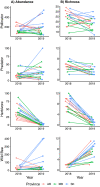Flower plantings promote insect pollinator abundance and wild bee richness in Canadian agricultural landscapes
- PMID: 35783668
- PMCID: PMC9237205
- DOI: 10.1007/s10841-022-00400-8
Flower plantings promote insect pollinator abundance and wild bee richness in Canadian agricultural landscapes
Abstract
Abstract: Global declines in pollinator populations are an ongoing concern from biodiversity and food security viewpoints. A growing conservation initiative in agricultural landscapes is the establishment of wildflowers on marginal lands to provide floral resources and habitat for pollinators. However, the effectiveness of such conservation and restoration efforts are not always assessed. We assessed the effectiveness of a private sector pollinator conservation initiative by (1) comparing insect abundance and richness between planted flower plots and control plots and (2) assessing changes between years. Over two years, planted flower plots and control plots (i.e. out-of-production farm areas) located in Canada were surveyed for insects using visual observation, netting, and pan trapping methods. Significantly more pollinators, especially wild bees, and higher wild bee richness were found in planted plots than control plots. Plot size had no effect on insect abundance and richness indicating that even small-scale flower plantings can provide benefits to pollinator communities. While pollinator, predator, and herbivore arthropod abundance and richness were stable or declined between years, likely due to adverse weather conditions in the second year of the study, wild bee abundance and richness increased over the same period. Our results support that flower plantings can be a successful conservation tool to increase pollinator and wild bee abundance and biodiversity within agricultural landscapes.
Implications for insect conservation: Small-scale flower plantings within agricultural landscapes are a simple and effective conservation management strategy to support local insect pollinator populations.
Supplementary information: The online version contains supplementary material available at 10.1007/s10841-022-00400-8.
Keywords: Biodiversity; Conservation; Floral resources; Habitat enhancement; Native bees.
© The Author(s), under exclusive licence to Springer Nature Switzerland AG 2022.
Conflict of interest statement
Conflict of interestThe authors declare no conflict of interest.
Figures



References
-
- Bates D, Maechler M, Bolker B, Walker S. Fitting linear mixed-effects models using lme4. J Stat Software. 2015;67(1):1–48. doi: 10.18637/jss.v067.i01. - DOI
-
- Bezte, D. (2020) Looking back at 2019’s weather stories. Manitoba Co-operator, Winnipeg, MB, Canada. https://www.manitobacooperator.ca/weather/looking-back-at-2019s-weather-.... Accessed: October 22, 2020.
-
- Blaauw BR, Issacs R. Flower plantings increase wild bee abundance and the pollination services provided to a pollination-dependent crop. J Appl Ecol. 2014;51:890–898. doi: 10.1111/1365-2664.12257. - DOI
-
- Bohart RM, Menke AS. Sphecid wasps of the world: a generic revision. Berkeley: University of California Press; 1976.
LinkOut - more resources
Full Text Sources
